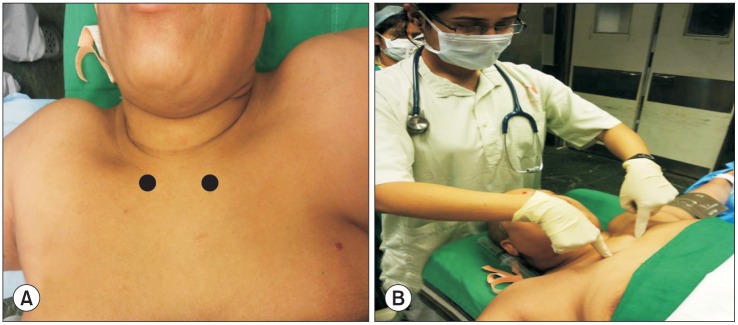1. Tweed WA, Dakin D. Explosive coughing after bolus fentanyl injection. Anesth Analg. 2001; 92:1442–1443. PMID:
11375822.

2. Lim KJ, Lee SK, Lee HM, Park EY, Kim MH, Kim YS, et al. Aspiration pneumonia caused by fentanyl-induced cough -a case report-. Korean J Anesthesiol. 2013; 65:251–253. PMID:
24101960.

3. Lin JA, Yeh CC, Lee MS, Wu CT, Lin SL, Wong CS. Prolonged injection time and light smoking decrease the incidence of fentanyl-induced cough. Anesth Analg. 2005; 101:670–674. PMID:
16115973.

4. Lin CS, Sun WZ, Chan WH, Lin CJ, Yeh HM, Mok MS. Intravenous lidocaine and ephedrine, but not propofol, suppress fentanyl-induced cough. Can J Anaesth. 2004; 51:654–659. PMID:
15310631.

5. Böhrer H, Fleischer F, Werning P. Tussive effect of a fentanyl bolus administered through a central venous catheter. Anaesthesia. 1990; 45:18–21. PMID:
2316832.

6. Phua WT, Teh BT, Jong W, Lee TL, Tweed WA. Tussive effect of a fentanyl bolus. Can J Anaesth. 1991; 38:330–334. PMID:
2036693.

7. Yu H, Yang XY, Zhang X, Li Q, Zhu T, Wang Y, et al. The effect of dilution and prolonged injection time on fentanyl-induced coughing. Anaesthesia. 2007; 62:919–922. PMID:
17697219.

10. Bickerman HA, Barach AL. The experimental production of cough in human subjects induced by citric acid aerosols; preliminary studies on the evaluation of antitussive agents. Am J Med Sci. 1954; 228:156–163. PMID:
13180508.

11. Dicpinigaitis PV, Rauf K. The influence of gender on cough reflex sensitivity. Chest. 1998; 113:1319–1321. PMID:
9596313.

12. Oshima T, Kasuya Y, Okumura Y, Murakami T, Dohi S. Identification of independent risk factors for fentanyl-induced cough. Can J Anaesth. 2006; 53:753–758. PMID:
16873340.

13. Lin JA, Yeh CC, Lee MS, Wu CT, Lin SL, Wong CS. Prolonged injection time and light smoking decrease the incidence of fentanyl-induced cough. Anesth Analg. 2005; 101:670–674. PMID:
16115973.

14. Pandey CK, Raza M, Ranjan R, Singhal V, Kumar M, Lakra A, et al. Intravenous lidocaine 0.5 mg.kg-1 effectively suppresses fentanylinduced cough. Can J Anaesth. 2005; 52:172–175. PMID:
15684258.

15. Paintal AS. Mechanism of stimulation of type J pulmonary receptors. J Physiol. 1969; 203:511–532. PMID:
5387024.

16. Sant'Ambrogio FB, Sant'Ambrogio G. Circulatory accessibility of nervous receptors localized in the tracheobronchial tree. Respir Physiol. 1982; 49:49–73. PMID:
7146645.
17. Yasuda I, Hirano T, Yusa T, Satoh M. Tracheal constriction by morphine and by fentanyl in man. Anesthesiology. 1978; 49:117–119. PMID:
686415.

18. Pandey CK, Raza M, Ranjan R, Lakra A, Agarwal A, Singh U, et al. Intravenous lidocaine suppresses fentanyl-induced coughing: a doubleblind, prospective, randomized placebo-controlled study. Anesth Analg. 2004; 99:1696–1698. PMID:
15562056.

19. Ambesh SP, Singh N, Gupta D, Singh PK, Singh U. A huffing manoeuvre, immediately before induction of anaesthesia, prevents fentanylinduced coughing: a prospective, randomized, and controlled study. Br J Anaesth. 2010; 104:40–43. PMID:
19933512.

20. Agarwal A, Azim A, Ambesh S, Bose N, Dhiraj S, Sahu D, et al. Salbutamol, beclomethasone or sodium chromoglycate suppress coughing induced by iv fentanyl. Can J Anaesth. 2003; 50:297–300. PMID:
12620955.
21. Horng HC, Wong CS, Hsiao KN, Huh BK, Kuo CP, Cherng CH, et al. Pre-medication with intravenous clonidine suppresses fentanylinduced cough. Acta Anaesthesiol Scand. 2007; 51:862–865. PMID:
17578464.

22. Sun ZT, Yang CY, Cui Z, Zhang J, Han XP. Effect of intravenous dezocine on fentanyl-induced cough during general anesthesia induction: a double-blinded, prospective, randomized, controlled trial. J Anesth. 2011; 25:860–863. PMID:
21935685.

23. Du BX, Cao L, Zhao WL, Xu ZH, Song J, Shi XY. Pre-emptive small dose of fentanyl suppresses fentanyl-induced cough: a meta-analysis of randomized controlled trials. Int J Clin Exp Med. 2014; 7:826–836. PMID:
24955151.
24. Boehler M, Mitterschiffthaler G, Schlager A. Korean hand acupressure reduces postoperative nausea and vomiting after gynecological laparoscopic surgery. Anesth Analg. 2002; 94:872–875. PMID:
11916788.

25. Lee A, Done ML. The use of nonpharmacologic techniques to prevent postoperative nausea and vomiting: a meta-analysis. Anesth Analg. 1999; 88:1362–1369. PMID:
10357346.





 PDF
PDF Citation
Citation Print
Print


 XML Download
XML Download